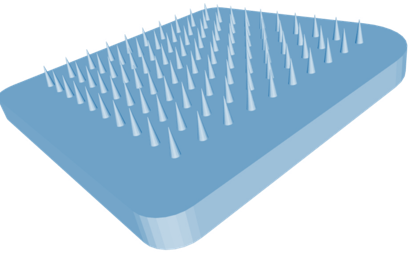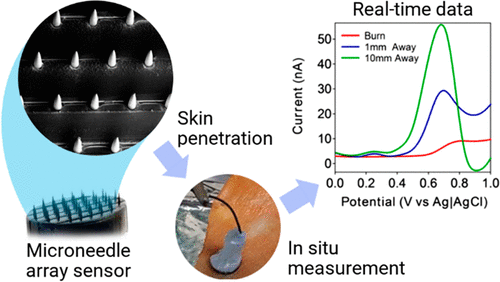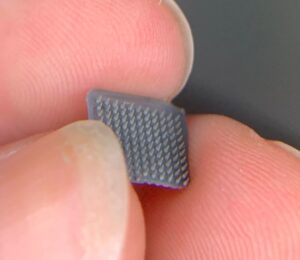Our research aims to advance precision medicine and theranostics through the development and integration of:
- targeted drug delivery systems,
- accessible diagnostic technologies,
with a particular interest in transdermal microneedles and nanotechnology.
Our work has been funded by the EPSRC, MRC, Innovate UK, Research England, Wellcome Trust and Northern Accelerator.
Our current projects focus on the following areas:
Disease detection in the skin
What if you could place a patch on the skin just for a few minutes to know your health status, cancer risk, or whether it’s COVID-19 or just a very bad cold? Our research aims to make that a reality with our microneedle (that is, ‘microscopic needle’) biosensors. We are developing microneedle patches that can capture biomarkers painlessly in the skin, and analyse them in real-time or rapidly, to diagnose disease. Using this technology, we aim to make disease detection and health monitoring more rapid and accurate, but less invasive.


Each microneedle biosensor carries an array of microneedles that can be inserted painlessly into the skin to extract and analyse biomarkers from various skin depths, with minimal discomfort to the user. It is rapid (analysis takes only a few minutes to a few hours), highly specific and sensitive. We hope the technique will replace invasive skin biopsies and syringe needles to diagnose skin diseases rapidly and accurately, in a more patient-friendly manner.

Drug delivery in the skin
Delivering drugs across the skin is hard work, thanks to the very effective skin barrier whose job it is to protects us from potentially harmful chemicals in the environment. Our work on dermal drug delivery aims to widen the scope of drugs deliverable via the skin, focusing on a number of formulation approaches involving chemical and physical penetration enhancement, such as transdermal microneedle technology. Our most recent innovation in this area has been a versatile and tunable material that can release a drug continuously from a microneedle patch for nearly 2 months following a single dose. We are now focusing on fully characterising the material and investigating its performance in different dosage forms and routes of administration, while seeking collaborations and partnerships to commercialise the technology.

This work has been featured on Serbian national television:
Understanding and bioengineering the skin
We want to understand the skin better, in health and disease. This knowledge is fundamental to our ability to evaluate our technologies for drug delivery and disease detection in the skin. So we also study how the skin should–and does–behave under laboratory test conditions. We usually do this using excised animal skin. We then use this knowledge to bioengineer skin models that we hope one day will be a like-for-like replacement for animal skin. This will not only help us reduce our reliance on animal tissues for experimentation, but we learn a great deal about the skin in the process, too.
